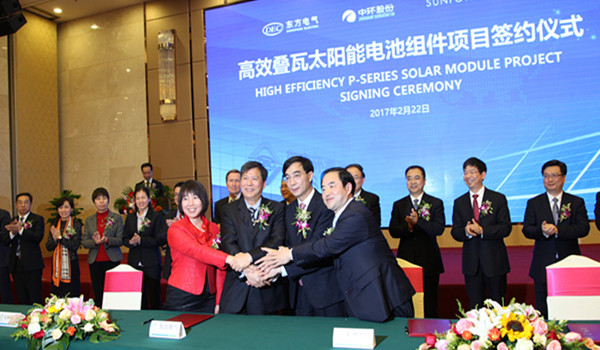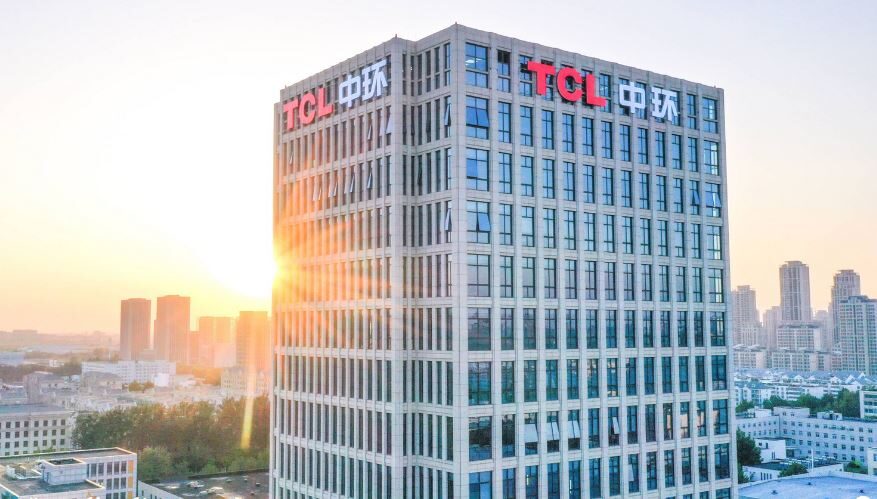After years of losing money on high-efficiency solar, SunPower last week finalized an agreement that will allow it to build what may end up being the world’s largest solar factory for its lower-cost P-Series modules in China.
At a ceremony on February 22, SunPower, industrial group Dongfang Electric and silicon giant Zhonghuan Semiconductor agreed to a joint venture to establish a factory with 21 production lines in an industrial district in Yixing City, in China’s Jiangsu Province.
No date for completion of the factory was given in statements on the Dongfang Electric or Zhonghuan Semiconductor sites, however Dongfang did state that once the factory is completed, DEC Dongfang Huanchen will rank among the top 10 solar module suppliers in the world.
The production facility will be the expansion of an existing factory and will build on the existing relationship between the companies. Dongfang and Zhonghuan are SunPower suppliers.
The P-Series is a dramatic departure from SunPower’s high-efficiency back-contact monocrystalline designs, and will feature overlapping half-cut multicrystalline PV cells. These will feature lower efficiencies of only 16-17.2%, but at a much lower cost than the company’s E-Series and X-Series modules, and are designed for deployment in competitive power markets, including in the developing world.
The only hint SunPower gave of this joint venture in its recent quarterly earnings call was to suggest that the company “plans on expanding our relationships in China to leverage low-cost China supply chain from our P-Series technology”. However, SunPower also forecast that it would reach over 400 MW of P-Series production by the end of 2017.
U.S. tariffs on Chinese solar products will mean that P-Series modules made by DEC Dongfang Huanchen will be at a relative disadvantage in the U.S. market. However, SunPower claims a pipeline of 850 MW of solar projects in Latin America, where such tariffs will not apply, and has also said that it plans to expand its activities in the Indian market.
This content is protected by copyright and may not be reused. If you want to cooperate with us and would like to reuse some of our content, please contact: editors@pv-magazine.com.



Please correct your statement regarding ” After years of losing money on high-efficiency solar” How did the company stay alive all these years if they lost money on high efficiency panels??? The company was founded in 1985 and you do the math! They did lose money just like every solar company during some transition times in the industry, but that is measured in quarter and not several Years!!!
Also, regarding the 16-17.2% efficiency, they have 17.2 % now and what is being build will have 19%!!! in 2018 18% targetted.
However your article misleads the readers to believe that the new factory will only have 16% efficient modules. That is also incorrect!
Check your facts and please revise it accordingly.
Hello Mr. Parfenov,
There is no need to correct my statement on SunPower losing money. SunPower’s own quarterly and annual financial statements attest to the fact that they indeed have reported net losses every quarter for at least six quarters, meaning net losses for the full years 2015 and 2016:
https://pv-magazine-usa.com/2017/02/16/sunpower-reports-heavy-losses-in-q4-results/
The conditions in 1985 were much different than today. Following a massive build-out of Chinese capacity starting around 2011, the market has been much more competitive, and it hasn’t been kind to SunPower. The company has survived in part by being bought by Total. It’s a lot easier to stay afloat with the backing of one of the world’s largest oil companies.
Also, during a period where most PV makers were in the black in 2015 and early 2016, SunPower was still losing money every quarter.
SunPower’s data sheets show 16-17.2% efficient P-Series modules. Argue with those, not me:
https://us.sunpower.com/sites/sunpower/files/media-library/data-sheets/ds-sunpower-p17-355-commercial-solar-panels.pdf
and: https://us.sunpower.com/sites/sunpower/files/media-library/data-sheets/ds-sunpower-p17-355-1500v-commercial-solar-panels.pdf
Some advice for you: Review the publicly available financial results and data sheets before you ask others to check their facts.
Christian Roselund
Americas editor
pv magazine